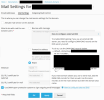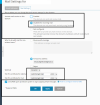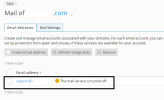pleskuser67553
Basic Pleskian
Username:
TITLE
Outgoing email messages not DKIM signed when enabled for a domain and in server settings
PRODUCT, VERSION, OPERATING SYSTEM, ARCHITECTURE
Plesk Obsidian 18.0.49/50, CentOS Linux 7.9.2009, Intel
PROBLEM DESCRIPTION
For any given domain, in Mail Settings, "Use DKIM spam protection system to sign outgoing email messages" is checked enabled, but in some circumstances outbound email messages are not signed from said domain. It's necessary to switch DKIM off and on again to get it to work.
to get it to work.
STEPS TO REPRODUCE
Ensure that "Allow signing outgoing mail" is checked in Tools & Settings > Mail Server Settings.
ACTUAL RESULT
It appears dis/enabling DKIM works independently from whether the mail service is enabled on a domain, which is helpful and desired, but to me, the Mail Settings UI does not imply that it is independent - certainly, it's not explicit.
Either way, enabling DKIM is not working every time and it is sometimes necessary to disable and reenable DKIM on mail settings on the domain to get a fresh key.
EXPECTED RESULT
Enabling DKIM on a domain should sign the domain's outbound emails.
If this setting is enabled but messages are not being signed, a warning should be in the logs and/or show in Diagnose & Repair and/or popup a warning telling the user this and/or recommend disable and reenable to get a fresh key.
Perhaps also make it clear to users in the UI that disabling and reenabling DKIM on a domain will generate a new key! Especially helpful for those whose DNS is external.
ANY ADDITIONAL INFORMATION
Diagnose & Repair does not pick up this issue.
As well as trying to sign outbound messages from a customer's domain, I was looking in the docs for how to DKIM sign outbound plesk notifications - if it is recommended the route which I have taken, e.g. adding a domain that matches the server hostname, adding the panel.ini [notification] setting and then enabling DKIM on the domain's mail settings, then it would be good to see this documented as it will help other admins. But also, a shortcut for enabling DKIM signing of plesk notifications would be nice too.
Related but not part of this bug - would be helpful if:
YOUR EXPECTATIONS FROM PLESK SERVICE TEAM
Confirm bug
TITLE
Outgoing email messages not DKIM signed when enabled for a domain and in server settings
PRODUCT, VERSION, OPERATING SYSTEM, ARCHITECTURE
Plesk Obsidian 18.0.49/50, CentOS Linux 7.9.2009, Intel
PROBLEM DESCRIPTION
For any given domain, in Mail Settings, "Use DKIM spam protection system to sign outgoing email messages" is checked enabled, but in some circumstances outbound email messages are not signed from said domain. It's necessary to switch DKIM off and on again
STEPS TO REPRODUCE
Ensure that "Allow signing outgoing mail" is checked in Tools & Settings > Mail Server Settings.
- Go to an existing domain > Mail Settings.
- Activate mail service on this domain is checked enabled - if not, check the box. Check Use DKIM spam protection system to sign outgoing email messages. Apply
- Outbound messages are signed
- Disable mail service but leave DKIM enabled, Apply
- Outbound messages are not signed
- Disable DKIM, do not enable mail service, Apply
- Enable DKIM, Apply (new public key is generated, update DNS if external)
- Outbound messages are signed
- Hostname is set for the server in Tools & Settings > Server Settings (let's say for this myserver.example.com - yes, mine is on a subdomain)
- Create or go to the domain that matches the hostname of the server, myserver.example.com
- DKIM is enabled in Mail Settings at some point (sorry I can't be more specific)
- Add to panel.ini
[notification]
senderAddress=[email protected] - Outbound plesk notification emails come from the expected address but are not signed
- Disable DKIM, do not enable mail service or mail service is not enabled, Apply
- Enable DKIM, Apply (new public key is generated, update DNS if external)
- Outbound Plesk notification messages are signed
ACTUAL RESULT
It appears dis/enabling DKIM works independently from whether the mail service is enabled on a domain, which is helpful and desired, but to me, the Mail Settings UI does not imply that it is independent - certainly, it's not explicit.
Either way, enabling DKIM is not working every time and it is sometimes necessary to disable and reenable DKIM on mail settings on the domain to get a fresh key.
EXPECTED RESULT
Enabling DKIM on a domain should sign the domain's outbound emails.
If this setting is enabled but messages are not being signed, a warning should be in the logs and/or show in Diagnose & Repair and/or popup a warning telling the user this and/or recommend disable and reenable to get a fresh key.
Perhaps also make it clear to users in the UI that disabling and reenabling DKIM on a domain will generate a new key! Especially helpful for those whose DNS is external.
ANY ADDITIONAL INFORMATION
Diagnose & Repair does not pick up this issue.
As well as trying to sign outbound messages from a customer's domain, I was looking in the docs for how to DKIM sign outbound plesk notifications - if it is recommended the route which I have taken, e.g. adding a domain that matches the server hostname, adding the panel.ini [notification] setting and then enabling DKIM on the domain's mail settings, then it would be good to see this documented as it will help other admins. But also, a shortcut for enabling DKIM signing of plesk notifications would be nice too.
Related but not part of this bug - would be helpful if:
- the DNS config / public key was not behind the "How to configure external DNS" popup
- the UI made clear that the public key has been changed, e.g. by displaying a creation date/time
YOUR EXPECTATIONS FROM PLESK SERVICE TEAM
Confirm bug





